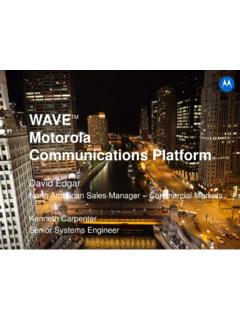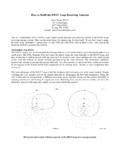Transcription of Overview of Radio Propagation. Common Reasons …
1 IWCE 2009 Jack Daniel Co, 2008 800-NON-TOLL page 1In-Building 101A Primer for RFDistribution TechnologyPresented byJack Daniel, Jack Daniel Overview of Radio propagation . Common Reasons for Dead Spots . Different Ways to Reduce Dead Spots. Types of Signal Boosters Distributed Antenna System designs FCC Signal Booster Rules Signal Booster Codes New Signal Booster Developments. Questions and Comments. Reasons Why In-Building Coverage is Important:Every Reason You Have anOutdoor Radio Systemapplies equally to having In-Building communications as time a First Responder enters a High Rise building,basement, subway or large mall chances are Public safety Radio communications may not be The FCC Rules identify special in-building amplifiersas Signal Boosters.
2 Within the wireless industry, a signal booster may also be called a Bi-Directional Amplifier or BDA . They are the same Some rf distribution designs may use radiating coaxial cables which are also called leaky coax .- A system that includes multiple inside antennas is called Distributed Antenna System or DAS .In-building Industry NomenclatureDOWNLINK:The RF direction of flow FROM a base station TO a Radio inside the :The RF direction of flow TO a base station FROM a Radio inside the SITE:A distant base or repeater ANTENNA:The antenna (typically on the roof) that connects the path to the Donor ANTENNA: Antennas used inside the structure, or "in-door" In-Building Coverage ProblemIn-building Industry NomenclatureIWCE 2009 Jack Daniel Co, 2008 800-NON-TOLL page 2 DONOR SITECOMPOSITE POWER.
3 The total power of all channels passed in a Class B signal that a Class B signal booster with a 10 watt rated output amplifier will NOT provide 10 watts on all the example, 10 equal level channels input to a10 watt broadband power amplifier will had 1 wattout put power per In-Building Coverage ProblemIn-building Industry NomenclatureDecibels are mathematical values of RF power levels or ratios. In RF system designs, watts and microvolts are converted to dBm s, a real amount relative to1 milliwatt power all values are converted to dBm, calculations are simply add and and losses are stated as RATIOS in dB s(not dBm) dB s are logarithmicso, for example;2x = 3 dB, 5x = 7 dB, 10x = 10 dB changesIn-building Industry NomenclatureDistributed Antenna System DAS The most commonly used term used to identify an in-building system consisting of multiple antennas placed inside the system engineers often interpret DAS as only a term that only applies to cellular systems.
4 DAS is used as verbal shorthand for almost all in-building RF distribution Industry NomenclatureThe cellular industry has established term that are now being adopted by other in-building system designers :PASSIVE:The portions that have no active devices, such as coax directly connected to a station or BDA with no further : A DAS system that includes rf amplification or RF conversion, such as in-line boosters or RF over fiber).HYBRID:A system that has both Passive and Active portions. This is the most Common after Distribution TypesRadio Signal PropagationIWCE 2009 Jack Daniel Co, 2008 800-NON-TOLL page 3 Radio Signal propagation Radio signals travel from point to point in a fashion similar to light.
5 Radio signals can penetrate some distance through many types of non-metallic obstacles like glass, wood, bricks, trees, fog, etc. As Radio signals pass through ANY obstacle,even air, they loose CLUTTER When Radio signals encounter metallic and masonry obstacles the signal is attenuated greatly and portions may be reflected away from the desired path. Weakened Radio signals reduce the range of the Radio system, both transmit and receive. Portables may receive in a structure but not send because of their lower transmit Signal propagation Buildings, especially basement , especially basement levels. Subways, , mines. Parking Garages. Naturally Shadowed Areas : Naturally Shadowed Areas : (Canyons, behind hills, river bottoms, etc.)
6 (Canyons, behind hills, river bottoms, etc.)In Public Safety In Public Safety A dead Spot can be A dead Spot can be a DEAD Spot!a DEAD Spot!Typical Areas of Poor RF CoverageIWCE 2009 Jack Daniel Co, 2008 800-NON-TOLL page 4 Mines. (1st signal booster use: 1978) Inside Buildings, especially lower floors. (City Halls, Hospitals, Colleges, Casinos) Convention Centers, Aquariums, Museums Basements, Tunnels, Underground Facilities. (EOCs, Utility services, VIP access, etc.) Malls, Auditoriums, Stadiums, Theaters. Stairwells and Areas of Poor RF CoverageNATURAL OBSTACLESSIGNAL BOOSTERS ARE NOTINTENDED TO BE USED TO INCREASETHE OUTDOOR RANGE OF A Radio SYSTEM, BOTH BY DESIGN AND FCC RULES!
7 Extending Radio System RangeIn-Building Coverage SolutionsPOOR COVERAGETHE COVERAGE PROBLEMGOOD COVERAGEB locked Signal Solution #1 Increase Transmit Power Portable Transmit power wont be increased, so only Talk-Out is improved. Will require FCC license modification. May have FCC ERP limitations. Will have to increase power by many multiples to have any notable improvement. Provides NO improvement if signal is blocked by a major obstacle. (Mtns, Basements, etc.)IWCE 2009 Jack Daniel Co, 2008 800-NON-TOLL page 5 Blocked Signal Solution #2 Build More Base Stations VERY expensive solution, especially when problem is in many widely scattered areas. Multiple bases or repeaters require additional equipment to network them to work as an integrated, manageable system.
8 Control circuits (microwave, telco lines) are required to link the sites together. Additional control console positions may be Signal Solution #3 Use Satellite Receivers Satellite receiver systems only address the talk-back side of the Radio conversation. Additional equipment (voting panels, console positions, etc.) will be required also. Links (microwave, telco lines, etc.) are required to all satellite receiver sites, causing higher monthly operating costs in most Signal Solution #4 Add Small Fill-In Repeaters inside problem areas. May requires additional Radio channels for cross-band communications. Only one channel may be available. Will require additional FCC licenses & fees.
9 Users have to know when to switch channels when moving from inside to outside and vice versa. A highly error prone procedure. A jammed fill-in repeater can block the whole Radio Signal Solution #5 Install Passive Antennas Low cost, low maintenance choice but only works well in less than 10% of cases. Requires VERY strong signals outside of the blocked area. Generally, must be less than 2 miles from base station/repeater site. User doesn t have to switch channels. If planned properly, signal boosters can be added if needed without wasted 2009 Jack Daniel Co, 2008 800-NON-TOLL page 6 Blocked Signal Solution #6 Install One-way Signal Boosters Can solve many unbalanced system problems where either the talk-out or talk-in is OK but the other is unsatisfactory.
10 Outside and Inside antenna system is similar to passive antenna system. User doesn t have to switch Radio channels. Also applies to in-building 1 way paging. Most economical signal booster Signal Solution #7 Blocked Signal Solution #7 Use Portable RepeatersUse Portable Repeaters Used by some Fire Departments Used by some Fire Departments Can improve coverage up to about 5 improve coverage up to about 5 floors. Requires logistical coordination to have at the Requires logistical coordination to have at the right place at the right place at the right time. Does not work for Simplex fire not work for Simplex fire channels. Users may have to switch may have to switch channels.








